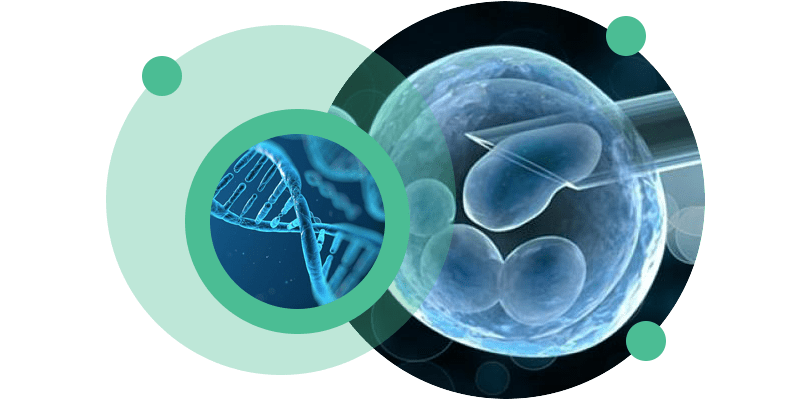Preimplantation Genetic Testing (PGT)
Preimplantation Genetic Testing (PGT) is defined as a technique for analysing the DNA of oocytes or embryos in order to detect genetic abnormalities.
PGT comprises three different types: PGT for the detection of aneuploidies (PGT-A), for the detection of monogenic diseases (PGT-M) and for the detection of structural genetic abnormalities (PGT-SR).

About Preimplantation Genetic Testing (PGT)
Preimplantation Genetic Testing (PGT) is defined as a technique for analysing the DNA of oocytes (polar blood cells) or embryos (in the cleavage or blastocyst phase) in order to detect genetic anomalies. At present, with the development of techniques and conditions for embryo culture and cryopreservation, the most common method is to perform PGD on cells taken from the trophoectoderm (outer layer) of the blastocyst, using a technique known as embryo biopsy.
Complex and advanced genetic analysis techniques are used to perform PGT.
There are three types of genetic diagnosis:
- PGD-A – used to detect aneuploidies, i.e. the existence of too many chromosomes (trisomies) or too few (monosomies) in relation to the 46 normal chromosomes (e.g. Down’s syndrome).
- PGT-M – used to screen for monogenic diseases (caused by a single gene). This test aims to reduce the risk of transmission of a certain disease caused by mutations in a single gene (e.g. cystic fibrosis).
- PGT-SR – used to screen for structural chromosomal abnormalities that can lead to a gain or loss of genetic material and generally result in miscarriage.
Embryos with a certain type of genetic alteration may prevent a pregnancy from occurring or reaching term, or they may give birth to a baby with a disease. The main aim of PGD will be to increase the likelihood of pregnancy and reduce the risk of transmitting genetic alterations or single-gene diseases to the offspring.
Preimplantation genetic tests are indicated in the following situations:
- Patients at risk of transmitting chromosomal changes to their offspring
- Patients at risk of transmitting a monogenic disease to their offspring
- Advanced maternal age (equal to or greater than 39 years)
- Successive implantation failures after IVF/ICSI cycles
- Patients with repeated clinical abortions
- Previous pregnancy with genetic anomaly
Carrying out a Preimplantation Genetic Testing treatment cycle involves obtaining embryos using Medically Assisted Reproduction techniques, namely Intracytoplasmic Sperm Microinjection (ICSI).
In general terms, the process comprises the following stages:
- ICSI treatment cycle – involves ovarian stimulation to develop several follicles simultaneously. These follicles are aspirated using a procedure called follicular puncture to collect the oocytes they contain. In the laboratory, after processing the ejaculate sample and the oocytes, the microinjection technique is performed. The fertilised oocytes are kept in culture and will continue to develop into embryos (blastocysts) for 5 to 6 days.
- Embryo biopsy – procedure carried out on embryos that are developing normally and have reached the blastocyst stage. In this procedure, certain cells are removed from the embryo and sent for the desired genetic analysis, depending on the pathology or clinical case in question. The embryos biopsied are cryopreserved until the genetic results are obtained.
Embryo transfer and/or disposal – once the genetic results have been obtained, embryos considered viable can be thawed and transferred to the patient’s uterus. Abnormal embryos will be thawed and discarded.
It is important to note that, as with all techniques, there is a certain percentage of error that can occur in the PGT.
The percentage of error in PGT-M/SR is between 1 and 5%, so the possibility of additional tests during pregnancy cannot be ruled out.
In the case of PGD-A, it is not possible to rule out an embryo being classified as transferable even if it has an abnormality. This may happen because aneuploidy is not detected due to technical limitations or because the embryo is composed simultaneously of normal and aneuploid cells (mosaicism) but the cells analysed were all normal. Given these limitations, it is possible to transfer aneuploid embryos but it is also possible to eliminate embryos that would give rise to a pregnancy and healthy babies.
It is also important to note that the Conseil National de la Procréation Médicalement Assistée (CNPMA) states that there is no evidence that PGD-A increases the success of MAP techniques.
Given the complexity of this subject and the limitations associated with genetic diagnosis, it is extremely important that all these issues are discussed with your doctor.
Common questions
An embryo is made up of several cells, not all of which have the same genetic make-up. An embryo suffering from mosaicism is made up of cells with a normal chromosomal composition and cells with aneuploidy.
A monogenic disease is caused by mutations in a single gene. Examples of these diseases include cystic fibrosis, fragile X syndrome and Huntington’s disease.
For a PGD treatment cycle to be completed, each stage of the process must proceed normally, i.e. it must be possible to collect oocytes and spermatozoa, fertilisation must take place, and the fertilised oocytes must give rise to embryos (blastocysts) of sufficient quality to withstand embryo biopsy and freezing/thawing procedures.
Only embryos classified as transferable, with no abnormalities, can be transferred into the patient’s uterus. Non-viable embryos will be thawed and discarded.
